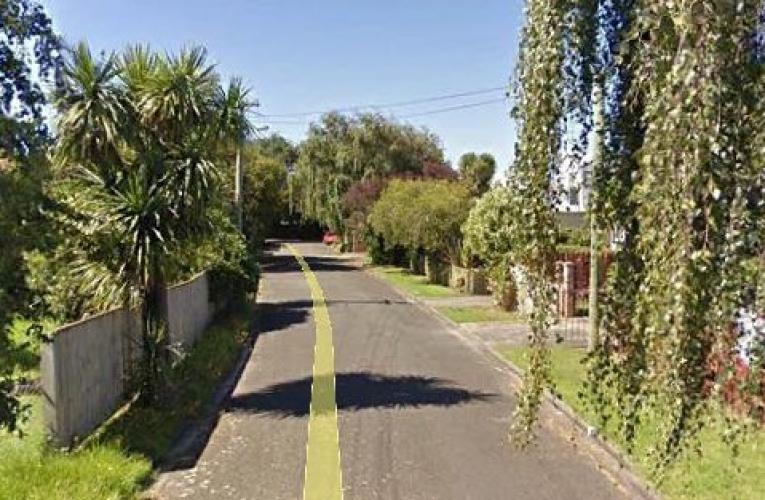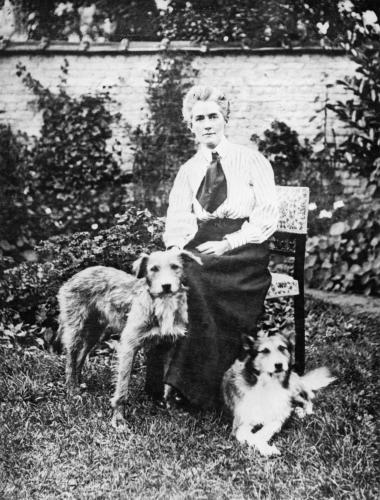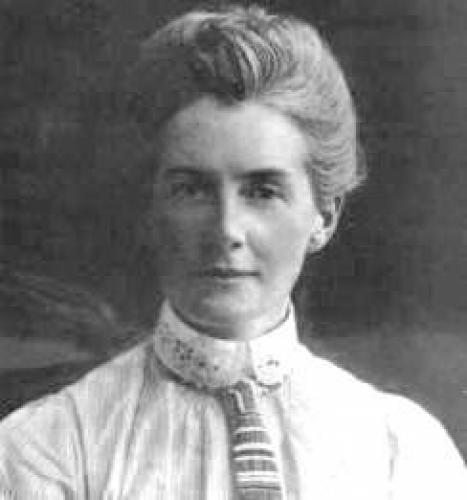077 Cavell Place Whanganui, street scene 2017
Reason for the name
This street was named in honour of Nurse Edith Louisa Cavell of WW1 fame. It is believed to be Edith Louisa Cavell a British nurse. She is celebrated for saving the lives of soldiers from both sides without discrimination and in helping some 200 Allied soldiers escape from German-occupied Belgium during the First World War, for which she was arrested. She was accused of treason, found guilty by a court-martial and sentenced to death. Despite international pressure for mercy, she was shot by a German firing squad.
Edith Louisa Cavell The night before her execution, she said "Patriotism is not enough. I must have no hatred or bitterness towards anyone." words later inscribed on a memorial to her near Trafalgar Square. Her strong Anglican beliefs propelled her to help all those who needed it, both German and Allied soldiers. She was quoted as saying, "I can’t stop while there are lives to be saved." The Church of England commemorates her in its Calendar of Saints on 12 October.
Author: The Poppy Places Trust
Cavell, who was 49 at the time of her execution, was already notable as a pioneer of modern nursing in Belgium
Cavell was born on 4 December 1865 in Swardeston, a village near Norwich, where her father was vicar for 45 years. She was the eldest of the four children of the Reverend Frederick Cavell and his wife Louisa Sophia. She was educated at Norwich High School for Girls, then boarding schools in Clevedon, Somerset and Peterborough (Laurel Court).
After a period as a governess, including for a family in Brussels 1890–1895, she returned home to care for her father during a serious illness. The experience led her to become a nurse after her father's recovery In April 1896, at the age of 30, Cavell applied to become a nurse probationer at the London Hospital under Matron Eva Luckes. She worked in various hospitals in England, including Shoreditch Infirmary (since renamed St Leonard's Hospital). As a private travelling nurse treating patients in their homes, Cavell travelled to tend patients with cancer, gout, pneumonia, pleurisy, eye issues and appendicitis.
In 1907, Cavell was recruited by Dr Antoine Depage to be matron of a newly established nursing school, L'École Belge d'Infirmières Diplômées, (or The Berkendael Medical Institute) on the Rue de la Culture (now Rue Franz Merjay), in Ixelles, Brussels. [1] By 1910, "Miss Cavell 'felt that the profession of nursing had gained sufficient foothold in Belgium to warrant the publishing of a professional journal' and, therefore, launched the nursing journal, L'infirmière". Within a year, she was a training nurse for three hospitals, 24 schools, and 13 kindergartens in Belgium.
When the First World War broke out, she was visiting her widowed mother in Norfolk. She returned to Brussels, where her clinic and nursing school were taken over by the Red Cross.
Cavell had been offered a position as a matron (a nurse that is in charge) in a Brussels clinic. She worked closely with Dr Depage who was part of a "growing body of people" in the medical profession in Belgium. He realised that the care that was being provided by the religious institutions had not been keeping up with other medical advances that were available at the time. In 1910 Cavell was asked if she would be the Matron for the new secular hospital at St Gilles.
In November 1914, after the German occupation of Brussels, Cavell began sheltering British soldiers and funnelling them out of occupied Belgium to the neutral Netherlands. Wounded British and French soldiers as well as Belgian and French civilians of military age were hidden from the Germans and provided with false papers by Prince Réginald de Croÿ at his château of Bellignies near Mons. From there, they were conducted by various guides to the houses of Cavell, Louis Séverin, and others in Brussels, where their hosts would furnish them with money to reach the Dutch frontier, and provide them with guides obtained through Philippe Baucq. This placed Cavell in violation of German military law. German authorities became increasingly suspicious of the nurse's actions, which were further fuelled by her outspokenness.
She was arrested on 3 August 1915 and charged with harbouring Allied soldiers. She had been betrayed by Gaston Quien, who was later convicted by a French court as a collaborator. She was held in Saint-Gilles prison for ten weeks, the last two of which were spent in solitary confinement. She made three depositions to the German police (on 8, 18 and 22 August), admitting that she had been instrumental in conveying about 60 British and 15 French soldiers, as well as about 100 French and Belgian civilians of military age, to the frontier and had sheltered most of them in her house.
In her court-martial she was prosecuted for aiding British and French soldiers, in addition to young Belgian men, to cross the border and eventually enter Britain. She admitted her guilt when she signed a statement the day before the trial. Cavell declared that the soldiers she had helped escape thanked her in writing when they arrived safely in Britain. This admission confirmed that Cavell had helped the soldiers navigate the Dutch frontier, but it also established that she helped them escape to a country at war with Germany. Her fellow defendants included Prince Reginald's sister, Princess Marie of Croÿ.
The penalty, according to German military law, was death. While the First Geneva Convention ordinarily guaranteed protection of medical personnel, that protection was forfeit if used as cover for any belligerent action. This forfeiture is expressed in article 7 of the 1906 version of the Convention, which was the version in force at the time. The German authorities instead justified prosecution merely on the basis of the German law and the interests of the German state.
The British government could do nothing to help her. Sir Horace Rowland of the Foreign Office said, "I am afraid that it is likely to go hard with Miss Cavell; I am afraid we are powerless." Lord Robert Cecil, Under-Secretary for Foreign Affairs, advised that, "Any representation by us, will do her more harm than good." The United States, however, had not yet joined the war and was in a position to apply diplomatic pressure. Hugh S. Gibson, First Secretary of the U.S. legation at Brussels, made clear to the German government that executing Cavell would further harm Germany's already damaged reputation. Later, he wrote:
We reminded [German civil governor Baron von der Lancken] of the burning of Louvain and the sinking of the Lusitania, and told him that this murder would rank with those two affairs and would stir all civilised countries with horror and disgust. Count Harrach broke in at this with the rather irrelevant remark that he would rather see Miss Cavell shot than have harm come to the humblest German soldier, and his only regret was that they had not "three or four old English women to shoot."
Baron von der Lancken is known to have stated that Cavell should be pardoned because of her complete honesty and because she had helped save so many lives, German as well as Allied. However, General von Sauberzweig, the military governor of Brussels, ordered that "in the interests of the State" the implementation of the death penalty against Baucq and Cavell should be immediate, denying higher authorities an opportunity to consider clemency. Cavell was defended by lawyer Sadi Kirschen from Brussels. Of the 27 defendants, five were condemned to death: Cavell, Baucq (an architect in his thirties), Louise Thuliez, Séverin and Countess Jeanne de Belleville. Of the five sentenced to death, only Cavell and Baucq were executed; the other three were granted reprieve.
Cavell was arrested not for espionage, as many were led to believe, but for 'treason', despite not being a German national. She may have been recruited by the British Secret Intelligence Service (SIS), and turned away from her espionage duties in order to help Allied soldiers escape, although this is not widely accepted. Rankin cites the published statement of M. R. D. Foot, historian and Second World War British intelligence officer, as to Cavell having been part of SIS or MI6. The former director-general of MI5, Stella Rimington, announced in 2015 that she had unearthed documents in Belgian military archives that confirmed an intelligence gathering aspect to Cavell's network. The BBC Radio 4 programme that presented Rimington's quote, noted Cavell's use of secret codes and, though amateurish, other network members' successful transmission of intelligence.
When in custody, Cavell was questioned in French, but the session was minuted in German; which gave the interrogator the opportunity to misinterpret her answers. Although she may have been misrepresented, she made no attempt to defend herself. Cavell was provided with a defender approved by the German military governor; a previous defender, who was chosen for Cavell by her assistant, Elizabeth Wilkins, was ultimately rejected by the governor.
The night before her execution, she told the Reverend Stirling Gahan, the Anglican chaplain who had been allowed to see her and to give her Holy Communion, "Patriotism is not enough. I must have no hatred or bitterness towards anyone."[20] These words are inscribed on her statue in St Martin's Place, near Trafalgar Square in London. Her final words to the German Lutheran prison chaplain, Paul Le Seur, were recorded as, "Ask Father Gahan to tell my loved ones later on that my soul, as I believe, is safe, and that I am glad to die for my country."
Sixteen men, forming two firing squads, carried out the sentence pronounced on her, and on four Belgian men at the Tir national shooting range in Schaerbeek, at 7:00 am on 12 October 1915.
On instructions from the Spanish minister, Belgian women immediately buried her body next to Saint-Gilles Prison. After the War, her body was taken back to Britain for a memorial service at Westminster Abbey and then transferred to Norwich, to be laid to rest at Life's Green on the east side of the cathedral. The King had to grant an exception to an Order in Council of 1854, which prevented any burials in the grounds of the cathedral, to allow the reburial.
George Bellows, The Murder of Edith Cavell, 1918, Princeton University Art Museum
From Wikipedia, the free encyclopedia






